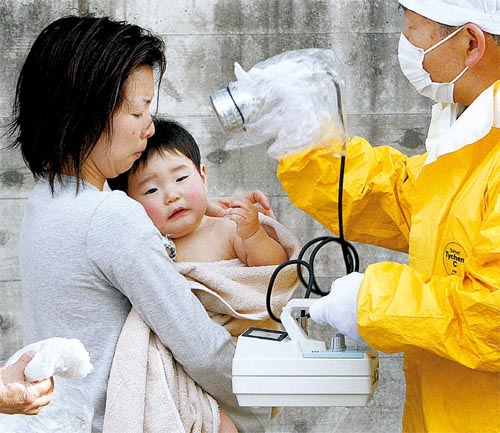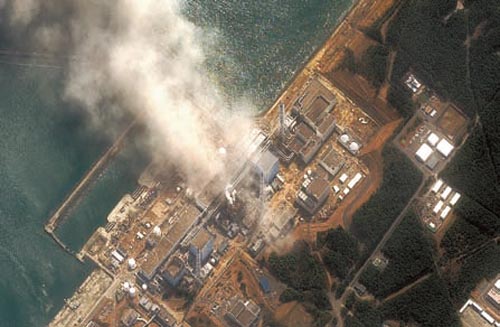World holds breath over Japan’s nuclear plant

A baby is checked for radiation exposure after being decontaminated in Fukushima, Japan, on March 14. [AP/YONHAP]
3월 14일 일본 후쿠시마에서 아기를 세척한 뒤 방사능 피폭 여부를 측정하고 있다. [AP/연합]
Radioactivity has become the top concern in quake-stricken Japan as a series of explosions rocked the already battered Fukushima Daiichi Nuclear Power Station yesterday.
* radioactivity: 방사능
* top concern: 가장 큰 우려
후쿠시마 다이이치 원전에서 어제 잇달아 폭발이 발생하면서 이미 지진으로 피해를 입은 일본에서 방사능 유출이 가장 시급한 문제로 떠올랐다.
The earthquake - now confirmed as a 9.0-magnitude quake by both the U.S. Geological Survey and the Japan Meteorological Agency - shook the plant, and the resulting tsunami crippled its cooling systems, causing fuel rods to become exposed to air, partially melting them.
* cripple: 불구로 만들다, 심각한 손상을 주다
미국지질조사연구소와 일본기상청이 모두 진도 9.0으로 확인한 지진이 원전을 뒤흔들었고, 뒤이은 쓰나미가 냉각시스템을 심각하게 손상시켜 핵 연료봉이 공기 중에 노출돼 일부 녹아 내렸다.
Around 6:15 a.m. yesterday the No. 2 reactor at the Fukushima Daiichi plant suffered a hydrogen explosion, possibly damaging a tank used to relieve pressure in the reactor. At 11:12 a.m., a fire broke out at the No. 4 reactor, which burst into flames after spent fuel rods stored there supposedly overheated and caught fire.
* hydrogen explosion: 수소폭발
* break out: 발생하다, 일어나다
* spent fuel rods: 폐연료봉

This satellite image provided by DigitalGlobe shows the damaged Fukushima Daiichi Nuclear Power Station in Japan on March 14. Authorities are struggling to prevent a catastrophic release of radiation. [AP/YONHAP]
디지털글로브사가 제공한 인공위성 사진에 3월 14일 손상된 일본의 후쿠시마 다이이치 원전의 모습이 보인다. 일본당국은 방사능 유출이라는 재앙을 막기 위해 사투를 벌이고 있다. [AP/연합]
어제 오전 6시15분쯤 후쿠시마 다이이치 원자로 2호기에서 수소폭발이 발생해 원자로내 압력을 낮추는 용기에 손상을 입힌 것으로 보인다. 오전 11시12분에는 원자로 4호기에 저장돼 있던 폐연로봉이 과열된 것으로 보이며 이로 인해 화재가 발생해 불길이 솟아올랐다.
Similar explosions had taken place at the plant's No. 1 and No. 3 reactors in the past few days. The situation is at a critical point as the primary containment vessel of the No. 2 reactor was damaged, with Tokyo Electric Power Co. saying that it could lead to a "meltdown" situation.
* take place: 발생하다
* critical point: 임계점, 기로, 위기
지난 몇 일 동안 비슷한 폭발이 1호기와 3호기에서도 발생했었다. 2호기의 격납용기가 손상을 입었고 도쿄전력이 “노심용융”으로 이를 수 있다고 밝히면서 심각한 상황으로 치닫고 있다.
In a press briefing shortly after the fire at the No. 4 reactor, Prime Minister Naoto Kan said radiation levels had risen. “The danger of a leak of radioactive material has been heightened,” said Kan. “Those living within 20 and 30 kilometers of the plant should not go outside but stay inside houses, offices and buildings.”
4호기에서 화재가 발생한 직후에 간 나오토 총리는 기자회견을 열어 방사능 유출 수준이 높아졌다고 말했다. “방사성 물질의 유출 위험 수위가 높아졌다. 원전에서 20킬로미터와 30킬로미터 이내에 살고 있는 주민들은 외출을 삼가고 집, 사무실, 건물 안에 머물러야 한다”고 간 총리는 말했다.
People living within a 20-kilometer (12.4-mile) radius of the plant have already been evacuated for fear of radiation exposure. In the afternoon, a no-fly zone was announced by the Japanese government 30 kilometers above the nuclear plant.
* radius: 반지름, 반경
* evacuate: 대피시키다, 피난하다
* no-fly zone: 비행금지구역
방사능 피폭 우려 때문에 원전으로부터 반경 20킬로미터 이내에 거주하는 주민들을 이미 대피시킨 상태다. 오후에 일본정부는 원전 상공 30킬로미터까지 비행금지구역으로 지정했다.
“Operations were halted at the No. 4 reactor at the time the earthquake happened on March 11, and we believe that the explosion occurred because the heat of the core generated hydrogen and exploded,” said Chief Cabinet Secretary Yukio Edano.
“지진이 발생했던 3월11일 당시에 원자로 4호기는 가동을 멈춘 상태였다. 노심이 과열돼 수소를 발생시켰고 그 수소가 폭발한 것으로 믿고 있다.”고 에다노 유키오 관방장관이 말했다.
Korea JoongAng Daily 1면 기사 Wednesday, March 16, 2011
번역: 이무영 정치사회부장 (mooyoung@joongang.co.kr)










with the Korea JoongAng Daily
To write comments, please log in to one of the accounts.
Standards Board Policy (0/250자)